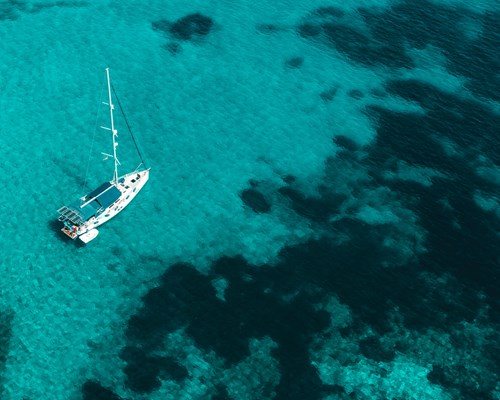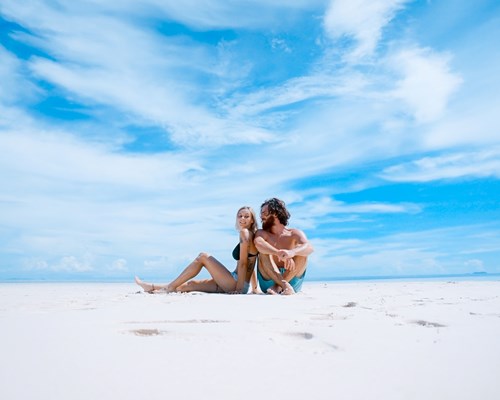Something of the old Caribbean, this awesome archipelago has managed to fend off development leaving Mother Nature architect-in-chief: she made St Vincent an isle of volcanoes, lush rainforest and weeping waterfalls. Dotted below it, gin-clear seas and white-sand beaches are the glories of the Grenadines.
Beaches in St. Vincent & the Grenadines
From the volcanic black and golden sands of St Vincent to the cotton white coasts of the Grenadines, there’s 84km of coastline here with endless bits to discover. All are public land and though some are easier to reach than others, a rainforest trek or boat trip to a hidden bay makes the experience all the more terrifically tropical.
Beaches in St Vincent & the Grenadines

St. Vincent
St Vincent’s black sand is said to have healing magnetic properties for its richness in iron - for us, the magnetism comes in the form of the lush greenery, rugged rocks, gurgling springs and tweeting birds.

Union Island
Union Island’s beach life is built around the keen kitesurf community, cool eco cafes serve mix ups of local produce and international snacks – like conch paninis. Bands play as the sun sets and rum punch tops off the cool, buzzy vibe.

Bequia
Bequia’s sailor’s paradise – boats dock on the marina, tots play with model double-enders in the shallows.

Palm Island
On uninhabited and private island resorts like Palm Island, the heavenly palmy, white sand scene is all yours with staff bringing your chosen cocktail straight to your sunbed.
St. Vincent & the Grenadines geography
St. Vincent & the Grenadines history
Wildlife in St. Vincent & the Grenadines
Activities in St. Vincent & the Grenadines
Watersports
Diving in St. Vincent & the Grenadines
With magnificent muck diving, curious caves, underwater volcanoes and a socking great barrier reef, SVG’s diving is almost impossible to beat. The water is insanely clear and warm year-round, and dive companies on all the main islands offer rentals, instruction and tours galore.
Ask anyone who knows anything about critter diving and they’ll tell you St Vincent has the best in the Caribbean. Look closely on the sea bed (which can be hard with hoards of corals, rays and turtles around you) and you can spot fascinating creatures including grass-like garden eels, camouflaged long-arm octopuses and fluorescent slender seahorses and mantis shrimps. You’ll rue the day you don’t bring a camera to capture the wonders – sometimes these can be hired from dive shops.
Home to one of the biggest barrier reefs in the Caribbean, the reef diving around St Vincent and the Grenadines is nothing short of awesome. Anchor Reef off Vincy’s leeward coast is one of the finest examples of black coral forests in existence, with swim-through holes and tunnels in a stunningly colourful wall.
Union Island’s shallow reefs are perfect for beginner dives, while Bequia’s intermediate friendly spots include Devil’s Table and Browns. The The Tobago Cays Marine Park is protected and one of our favourite areas in the world for reef diving or snorkelling with turtles.
When it comes to wrecks, these shallow, reef ridden waters – once used by pirates for plundering unfortunate ships – have some fabulous sites to swim around and through. Favourites are the sunken ferry off St Vincent (the Siemstrad), Bequia’s yachts, tug boats and (not your usual underwater feature) ATM machine, an English gun ship from 1918 off Mayreau (the Puruni) and a cruise liner (called Antilles), crane (the Johnas) and aeroplane (South Brittania) near Mustique.
For something different, you can dive in warm waters surrounding the underwater volcano off Mayreau, or into a spooky cave filled with bats on the edge of St Vincent.
Surfing in St. Vincent & the Grenadines
Surfing isn’t a massive activity in these parts – you’ll want Barbados for a full week of surfing. But that’s not to say you can’t catch some wonderful waves and dazzling downwinders here… Trade winds blow consistently between December and June, and while they merely rustle the palm leaves on most beaches, they form some super waves on Shipping Bay and Blue Lagoon on St Vincent, and Big Sand on Union Island in the Grenadines.
The Grenadines could’ve been made just for stand up paddleboarding, and hotels and activity centres are soon catching onto the SUP potential. You can borrow boards and paddles from the bigger resorts, while JT Pro Centre and Happy Kite on Union Island offer rentals and sometimes tours.
Pair your SUP hire with a boat trip and St. Vincent & the Grenadines is yours to roam – circuit pirate islands, picnic on empty beaches and watch turtles, nurse sharks and rays swim in the crazily clear water beneath you.
Windsurfing & kitesurfing in St. Vincent & the Grenadines
Trade winds blow steadily at 15 - 25 knots between December and July in the Grenadines, lagoons lie buttery flat under the Caribbean sun and kaleidoscopic coral reefs whip up playful waves. Launch spots can be found on palm-backed, white sand beaches, buzzing marinas, diddy desert islands and bang in the middle of the big blue. From aspiring kiters to competing pro’s, this awesome archipelago HAS to be on every kiteboarding bucket list.
Even if you’re based on the main isle of St V, the ease of island hopping makes reaching the best kite spots a breeze.
Union Island’s the main port of call, home to the JT Pro Center (run by local legend Jeremie Tronet) and Happy Kite, where you can hire equipment and book IKO instructors and guided safaris. Tronet’s transformed Anchorage Beach into kiting heaven, marking the best launch spots, installing a slider and pointing out the most deliciously flat bits for freestyle. Downwind from here, Frigate’s flat as a pancake with consistent offshore winds. Union’s third main spot is Big Sand, where waves bounce off a reef aided by a sideshore breeze.
In the protected Tobago Cays, parts are closed to watersports, but what’s not is kitesurf Shangri-la: likelihood is you’ll have the water - sometimes whole islets - to yourself (bar a turtle or two). The downwind back to Union Island will quite possibly be the ride of your life.
It doesn’t stop there – the waves off Palm Island’s reef are a joy to play about on and Canouan’s lagoon (nicknamed ‘The Pool’) is dizzyingly turquoise and flat as a flounder. Salt Whistle Bay on Mayreau is particularly popular and with good reason – combining shallow spots for leaners, flats for freestyle and a few waves off the nearby reef.
Sailing in St. Vincent & the Grenadines
A nation of seafaring islanders and stunning marinas, sailing is a huge part of life in St Vincent and the Grenadines. Anchorages can be found all over the archipelago, varying in size and facilities depending on each island’s level of development. Live onboard sailing courses set off from St Vincent, while resorts in the Grenadines offer hobie cats with instructors to show you the ropes. Both bareboat and crewed charters are widely available, letting you explore the 30+ islands or head further afield to St Lucia or Grenada.
Fishing in St. Vincent & the Grenadines
These islands have a bounty of fish in their waters, and deep-sea day trips and half-day trips will take you east into the Atlantic for the best catches.
Troll for the likes of yellowfin tuna, mahi mahi and wahoo or sail to where the Caribbean Sea meets the Atlantic and join locals jigging for snappers, groupers and the like. Closer to land, you can fish around the coasts of Union Island and Mayreau in the Grenadines. For fly fishing, permits and bonefish can be found on the flats around Union Island when it’s low tide - July to November is the best time of year.
Canoeing & kayaking in St. Vincent & the Grenadines
Canoe and kayak excursions are the perfect way to explore the hidden gems of the Caribbean that are inaccessible by foot. You may have to pinch yourselves as you glide across the shimmering sea, absorbing the surreal landscapes that encompass you. Use this opportunity to recce the more remote areas of the island, stealing a beach all for yourselves. The undisturbed marine life in these areas also make for more magical snorkelling escapades. If you’re brave enough, kayak through the bat caves, exploring the darkest corners of the island.
Land Activities
Golf in St. Vincent & the Grenadines
There’s only one championship golf course in St Vincent & the Grenadines, and you’ll find it on the island of Canouan. The Pink Sands Golf Club has formerly been known as the Grenadines Estate Golf Club and the Trump International. Whatever you know it as, the 18 hole, par 72 course was designed by the one and only Jim Fazio and is an absolute treat to play whether you’re staying on the island or hopping over from elsewhere. Divided into two loops, the front nine lead along the coast and the back nine take you up the hill for distractingly pretty views. Positioned along a high, breezy ridge, holes 12-15 are spectacularly scenic and challenging. If that doesn’t leave you sweating under the Caribbean sun, hole 16’s par 3 is one of the longest in the world at 305 yards… Bar island hopping to St Lucia or Grenada for a day’s round, if you want a week of golfing on different courses, you might be better off staying in the Dominican Republic or Barbados.
Cycling & mountain biking in St. Vincent & the Grenadines
Taking you all the way around tiddly islands and cays, down forested volcanic hills and along jaw-dropping coastlines – St. Vincent & the Grenadines cycling opportunity is incredible.
On St Vincent, the bicycle capital is Sailor’s Cycle Centre in Kingstown. Trevor (aka 'Sailor') and co hire out bikes and run a range of tours taking you on mountainsides, through valleys and over to the Atlantic coast. Bequia and Union Island have hire companies too, giving you the chance to peddle between beaches and fishing villages.
The big hotels and private island resorts often have their own fleet of bikes for guests – Palm Island’s nature trails are a treat to cycle around.
Walking & hiking in St. Vincent & the Grenadines
Whether you’re following the footsteps of a local guide or treading your own path at your own pace, these islands are awesome when it comes to walking. On St Vincent, you can scale the Soufriere volcano, follow lush rainforest trails and hike on the hunt for the tumbling Baleine, Trinity and Dark View waterfalls.
The general theme of the Grenadines is gently rolling hills and idyllic – often empty – beaches. We love the three nature trails on Palm Island, and Mayreau’s road to Saltwhistle Bay from Saline Bay is breezy and beautiful. On Jamesby, Petit Bateau and Petit Rameau in the Tobago Cays, you can wander desert isles and spot birds (like the tropical mockingbird and bananaquit) and iguanas.


